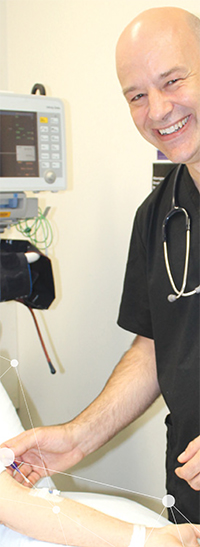Medical glue the clue to IV lines

Dr Simon Budgen
The researchers found that using medical skin glue to hold hospital drips in place significantly reduces the failure rate of IV lines.
Caboolture Hospital Senior Medical Officer Simon Bugden says the failure rate for IV lines in the first 48 hours was 29-40 per cent in Australia and as high as 90 per cent internationally. The research team at Caboolture Hospital found that by using medical skin glue, they could reduce the failure rate to below
17 per cent.
“The glue made IV lines harder to be accidentally knocked out and was also shown to kill the bacteria that most commonly cause infections,” Dr Budgen says.
“The other major benefit was patient comfort, with patients in the trial reporting that the glue felt more comfortable and they were less worried about the lines falling out.”
Health staff place more than 10 million IV lines in Australia each year. Reducing the need to replace IV lines will save staff time and free up valuable healthcare resources. The research was supported by a $50,000 grant from the Emergency Medicine Foundation. The trial was conducted over several months at Caboolture Hospital. The skin gluing method is currently undergoing a cost-benefit analysis by health economists at Griffith University, before considering rolling out the new procedure on a wide scale.
Emergency Medicine Foundation Chair Associate Professor Sally McCarthy says that despite failure rates of IVs, there has been no improvement to the current procedure for decades.
“This method has the potential to simply and costeffectively be introduced in hospitals worldwide,” Assoc Prof McCarthy says.
“The Emergency Medicine Foundation is committed to ensuring Australia continues to stay at the forefront of emergency medicine care, by funding research in this field.”
Dr Bugden’s research was recently published in the Annals of Emergency Medicine.
